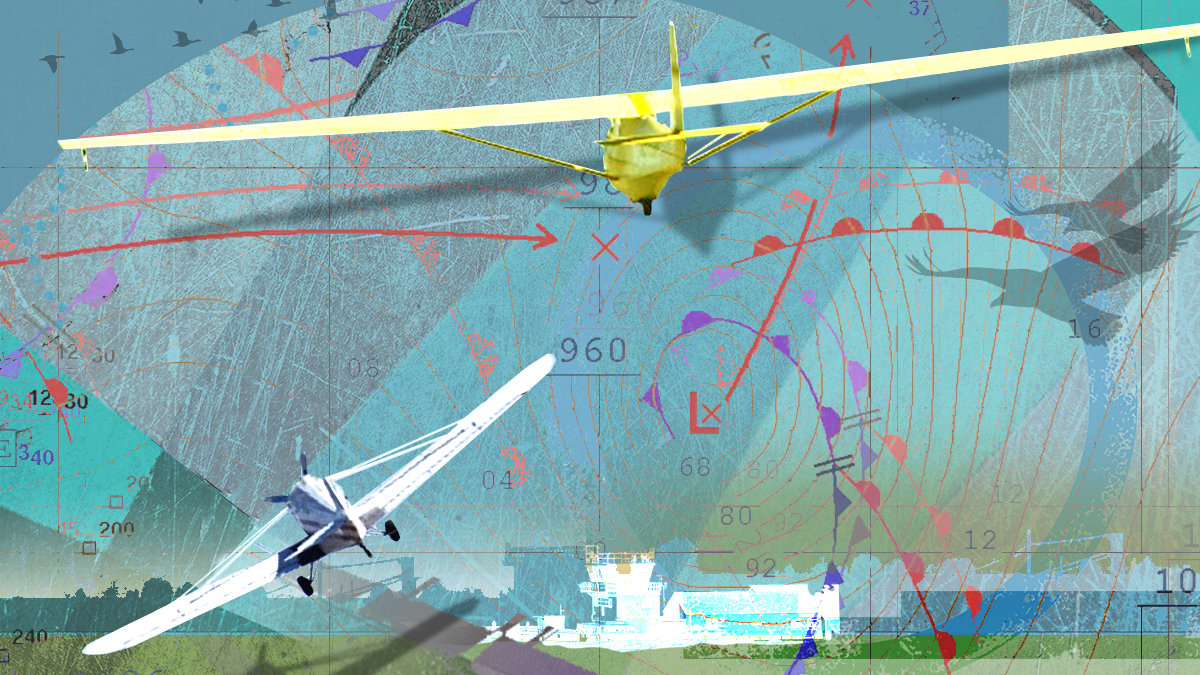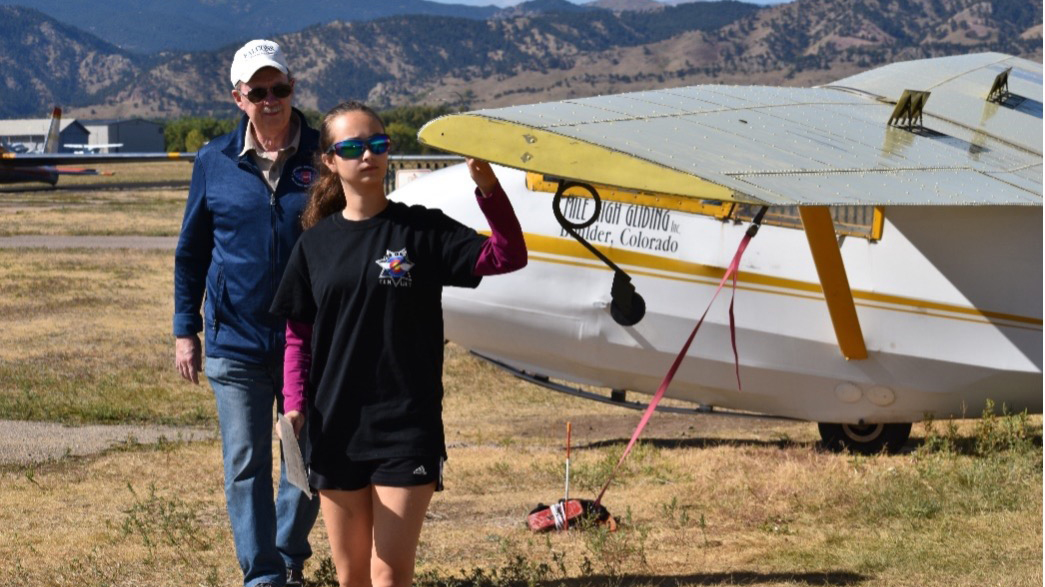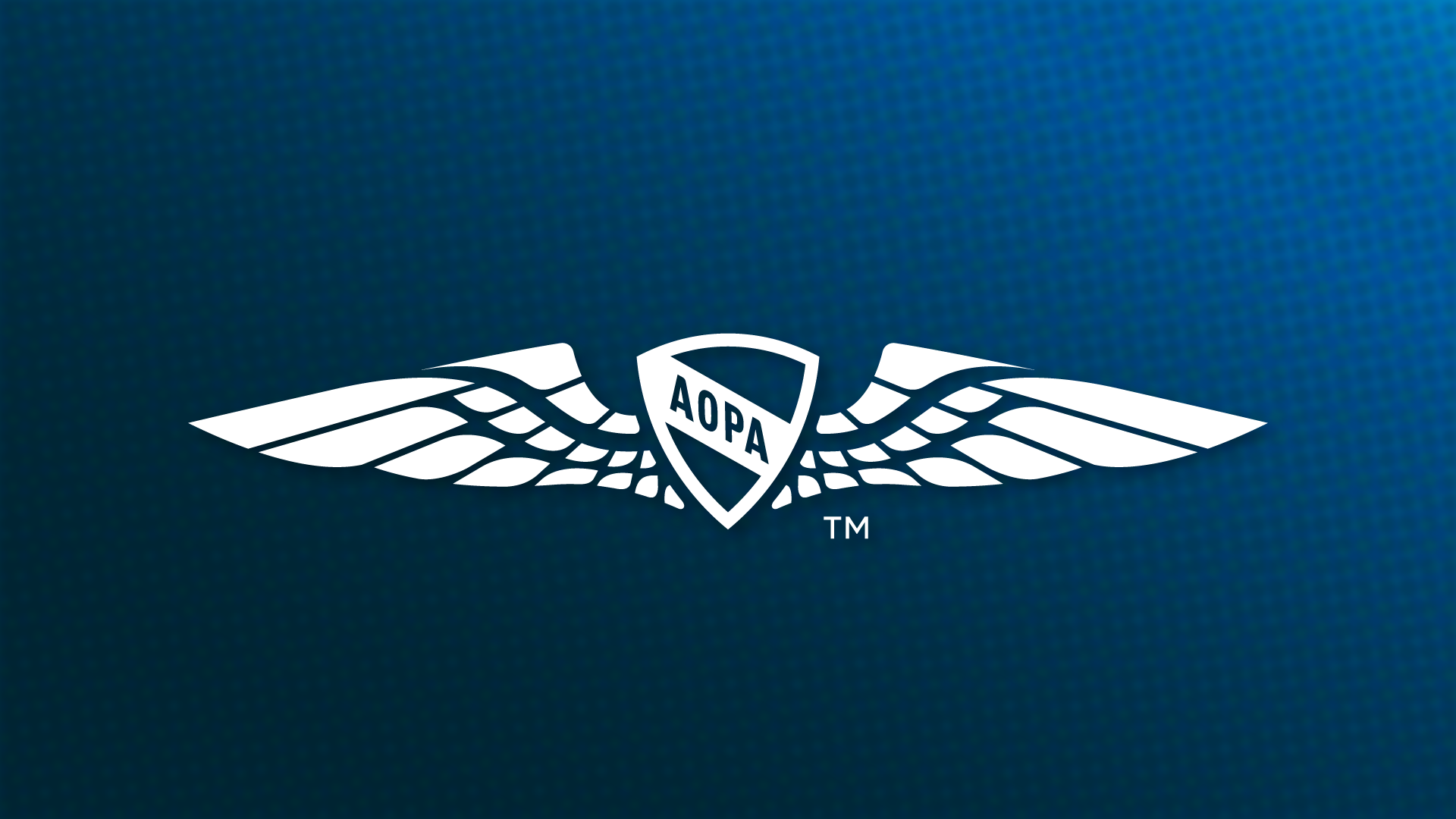Letting go to live
Lessons of persistence and resilience
By Makayla Galler
In the quiet of a cold winter morning, I stepped out of the little shack that served as the Mile High Gliding field office and onto the landing strip, ready for what I didn’t realize would become one of my most memorable flights. As a student glider pilot, each flight was a delicate balance between freedom and challenge, but this day tested me in unprecedented ways, pushing my skills and instincts to their limits.

Boulder Municipal Airport (BDU), nestled in the foothills of the Colorado Rockies, is a small, nontowered airfield, adding an element of unpredictability with every flight. You never knew what kind of wind you would get at any minute, as the Front Range weather had a way of keeping pilots on their toes. Occasionally, a hawk or lone eagle looking for prey would pay visit, or a flock of geese would soar nearby, demanding quick reflexes to avoid them. On the ground, foxes and coyotes often darted along the runway’s edge, turning landings into a test of precision. Once, an entire herd of wayward cattle wandered onto the runway, and it took a team of cowboys to corral them and clear the way. On this day, there were only patches of thawing ice and mud, serving as a reminder of the lingering winter.
Before I could solo and take off on my own, my CFI, retired U.S. Air Force Maj. Gen. John Barry, made it a ritual to join me for a presolo flight. His calm, no-nonsense manner always put me at ease, and these flights allowed us to check the weather and thermals together while giving me a chance to settle into the rhythm of the day. That morning, the flight was as smooth as ever, the glider responding like an extension of myself. It felt like a perfect start, and part of me began to expect the rest of the day would follow the same rhythm.
After we landed, Barry climbed out of the cockpit, brushed the snow off his jacket, and turned to me with his signature nod.
“You’ve got the skills, Makayla,” he said, his tone steady. “But skills only get you halfway there. You know what makes the difference?”
I thought for a moment, then shook my head.
“Persistence,” he said, “It’s not about being perfect, it’s about staying focused, no matter what the sky throws at you. Remember that.”
After this exchange, he left me alone in the cockpit for my solo flight. I glanced at the windsock, saw only a light breeze, and didn’t think much of it. Back then, I had plenty of confidence in my flying ability, but there was something about being alone in the sky that made me feel slightly anxious. Maybe it was just too quiet. It was the kind of silence that made every creak of the glider and whisper of the wind feel exaggerated, as though the sky itself was holding its breath.

It was takeoff time. The wing runner bent down beside the glider, skillfully attaching the tow rope to the hook beneath the glider nose. After double-checking to make sure everything was secure, he stepped back, looked at me for the go-ahead, and then signaled the towplane pilot with a thumbs up.
The towplane pilots were fearless and exceptional aviators. There was an unspoken connection of trust between us, defined by that single, slender rope. Every move they made in the cockpit affected my actions in the glider, and every move I made impacted theirs, creating a precise and coordinated dance. Trust wasn’t just a luxury; it was essential. Any mistake by either of us could turn a smooth flight into a deadly one. They were the ones who pulled me into the sky, guiding me safely through those first critical moments of flight. The key to being towed was maintaining a steady position behind the towplane, always keeping it in sight. The rope was your lifeline, and losing sight of the towplane, whether by dropping too low or climbing too high, could disrupt the delicate balance of the tow. It was a test of precision and focus. As the tow began, I felt a faint shift in the wind but brushed it off. I had done this many times before, and everything still felt under control.
There is no engine roar in a glider, just the wisps of the wind and the occasional creak of the wings. The glider we used was a two-seat training model with a rich history. Barry, who graduated from the U.S. Air Force Academy, once mentioned that he thought he had used the exact glider we were in during his time at the academy in the 1970s, almost 50 years ago. That was the beauty of my Schweizer SGS 2–33 glider: It was built to last. While single-engine airplanes often felt delicate and full of moving parts that could fail, the glider was simple, solid, and dependable. That glider had stories etched into every dent and scratch, and yet it soared just as gracefully as ever.
At 15, I knew that this simplicity, this pure form of flight, was preparing me for the more complex challenges of piloting single-engine aircraft. It taught me to listen to the wind and feel the airplane’s movements, skills that would serve me well when navigating more advanced aircraft. In those moments, I felt closer to the purity of flight more than ever, as if the sky and I were having a quiet conversation that only a glider pilot could understand.

During this seemingly routine tow, a sudden and powerful gust of wind forced my glider into an uncontrollable climb, pulling me far above the towplane. Then, the towplane vanished from sight as the tension on the rope surged. I realized too late that the conditions had changed. I had been flying with the confidence of routine, not with the alertness each new flight demands. Despite my efforts to correct the glider’s position, the relentless wind drove me higher and higher. For a moment, my thoughts began racing through all the potential outcomes. But then, as instinct took over, I felt a sense of calm. My training kicked in, and I refocused on the procedures I had practiced many times before.
Realizing the flight couldn’t safely continue, I made the decision to release early from the tow plane. The moment the rope detached, the towplane pilot saw I was in trouble and immediately banked away, clearing the area for my emergency maneuver. I pitched the glider down to regain control and stabilize the airspeed. Keeping my focus on the altimeter and airspeed indicator, I quickly evaluated my position relative to the runway. Recognizing that I couldn’t follow the standard landing pattern, I initiated a steep turn back toward the airfield, maintaining a coordinated turn to avoid a stall or losing altitude too quickly. With careful adjustments to the flight controls, I lined up with the runway and made sure my approach angle was stable. In contrast to the chaotic takeoff, the landing was probably the best and smoothest I had ever done, bringing the glider to a gentle stop as if nothing had gone wrong.
The whole event felt like a blur, but in that moment, I knew I had overcome one of the most intense challenges of my early flying experiences. As I climbed out of the cockpit and looked back at the path I had just taken, the realization hit me: This wasn’t just about flying, this was about resilience. That day, I didn’t just prove my ability to handle a glider; I proved to myself that no matter the challenges ahead, I could navigate through them with focus and determination.
Barry greeted me on the ground, his expression one of quiet pride. “So,” he said, patting the wing of the glider, “what did we learn?”
“Persistence,” I replied, the word feeling more profound now than it had that morning. “And that no two flights are ever the same. Confidence can blur good judgment if you’re not fully present.”
He nodded. “Every flight teaches us something new, and you just had one heck of a lesson.” I smiled, knowing he was right. But I also knew this flight had changed me. Never again would I let the calm of a previous flight lull me into a false sense of security. The sky is never the same twice, and I should have treated it that way. I missed the subtle warnings, the shifting gusts, and the uneasy rhythm of the tow because I was still flying the last flight in my head. Complacency creeps in quietly, and in a glider, quiet can be deadly.
The runway might have marked the end of this flight, but it was only the beginning of an endless horizon of possibilities. 
Makayla Galler is a private pilot with glider and single-engine land ratings pursuing a degree in aeronautical management technology at Arizona State University. Galler is the founder of Pilot Prodigies, an organization that broadens access to STEM education for underserved students.

